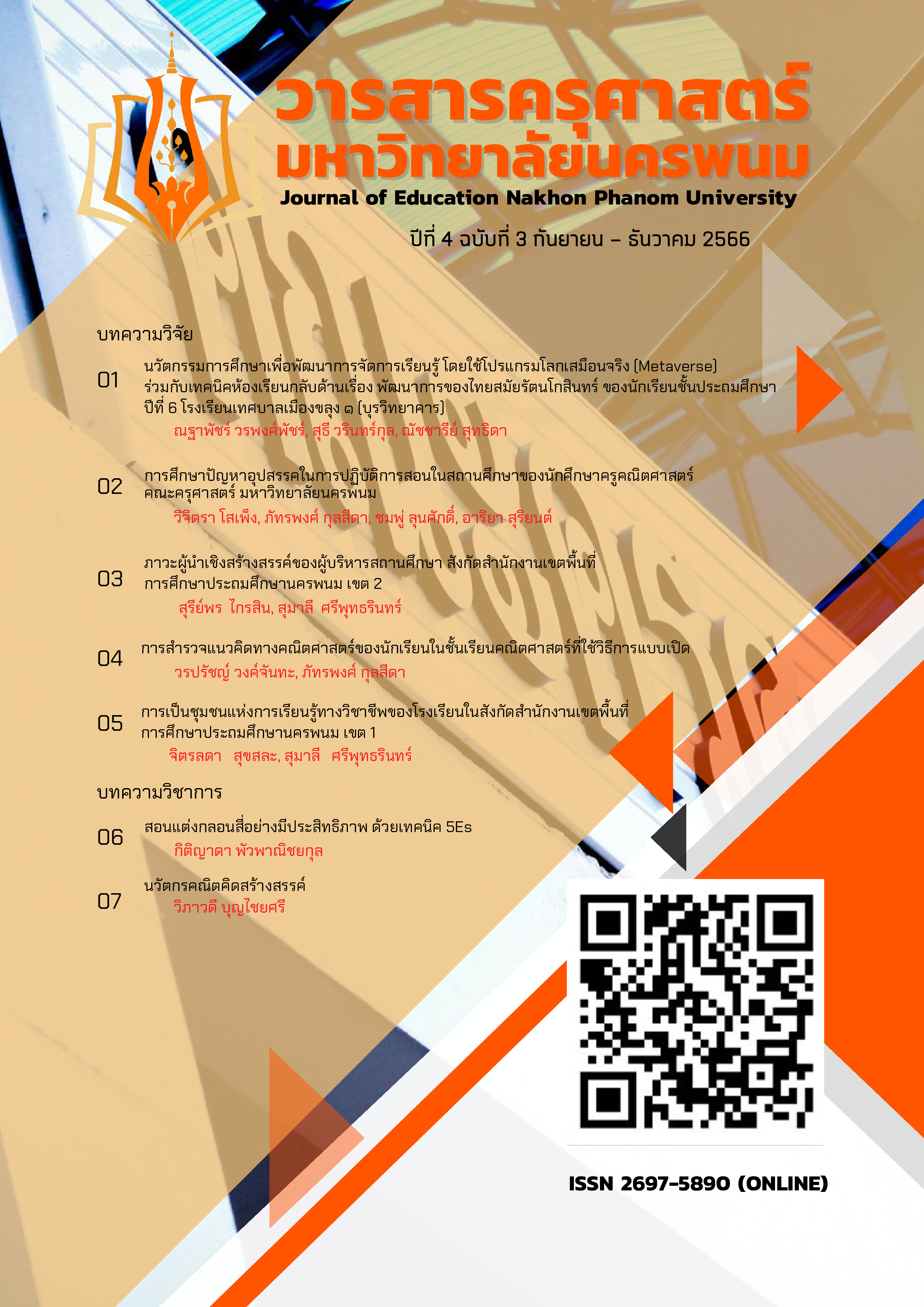Math Innovator Fostering Creativity วิภาวดี บุญไชยศรี
Main Article Content
Abstract
The key to developing students' creative thinking and leading them towards innovative achievements is the teaching approach of emphasising problem-solving processes with students themselves. This approach focuses on creating challenging situations that encourage students to develop systematic, self-directed problem-solving methods. The combination of two teaching approaches: Open Approach and the conceptual framework of Khon Kaen University Demonstration School has created SATIT KKU Creative Innovator Framework,which utilises both teaching approaches to enhance students. Both approaches excel in developing students by presenting challenging problems, encouraging self-motivation to seek solutions, and establishing self-driven knowledge-building systems. They provide different perspectives for problem identification and diverse problem-solving methods, ultimately leading to the creation of innovative ideas and solutions for various everyday life challenges that are constantly evolving.
Article Details

This work is licensed under a Creative Commons Attribution-NonCommercial-NoDerivatives 4.0 International License.
บทความที่ได้รับการตีพิมพ์เป็นลิขสิทธิ์ของวารสารครุศาสตร์ คณะครุศาสตร์ มหาวิทยาลัยนครพนม ข้อความที่ปรากฏในบทความแต่ละเรื่องในวารสารครุศาสตร์เล่มนี้เป็นความคิดเห็นส่วนตัวของผู้เขียนแต่ละท่านไม่เกี่ยวข้องกับมหาวิทยาลัยนครพนม และคณาจารย์ท่านอื่น ๆ ในมหาวิทยาลัยฯ แต่อย่างใด ความรับผิดชอบองค์ประกอบทั้งหมดของบทความแต่ละเรื่องเป็นของผู้เขียนแต่ละท่าน หากมีความผิดพลาดใด ๆ ผู้เขียนแต่ละท่านจะรับผิดชอบบทความของตนเองแต่ผู้เดียว
References
กนิษฐา พูลลาภ. (2563). การส่งเสริมความคิดสร้างสรรค์ด้วยการจัดการเรียนรู้แบบผสมผสาน ร่วมกับการเรียนรู้แบบสร้างสรรค์เป็นฐาน สำหรับนักเรียนห้องเรียน
พิเศษวิทยาศาสตร์ ชั้นมัธยมศึกษาปีที่ 4 โรงเรียนผดุงนารี. การประชุมวิชาการเสนอผลงานวิจัยระดับบัณฑิตศึกษาแห่งชาติ ครั้งที่ 21 วันที่ 27 มีนาคม
ณ มหาวิทยาลัยขอนแก่น, ขอนแก่น.
กระทรวงการอุดมศึกษา วิทยาศาสตร์ วิจัยและนวัตกรรม. ความหมายของนวัตกรและทักษะสำคัญของการเป็นนวัตกร. สืบค้นจาก
ดิเรก พรสีมา. (2559). ครูไทย 4.0. มติชน. สืบค้นจาก https://www.matichon.co.th/news/345042
ไมตรี อินทร์ประสิทธิ์ และคณะ. (2546). การปฏิรูปกระบวนการเรียนรู้วิชาคณิตศาสตร์ในโรงเรียน โดยเน้นกระบวนการทางคณิตศาสตร์. รายงานสภาวิจัย.
สานักงานคณะกรรมการวิจัยแห่งชาติ.
โรงเรียนสาธิตมหาวิทยาลัยขอนแก่น. (2562). หลักสูตรโรงเรียนสาธิตมหาวิทยาลัยขอนแก่นที่สร้างนวัตกรที่มีความคิดสร้างสรรค์(Creative Innovator). คณะ
ศึกษาศาสตร์. มหาวิทยาลัยขอนแก่น
วีรินยาอร เหลืองบริบูรณ์. (2564). นวัตกรรม คืออะไร. สืบค้นจาก #EASYINNOVATION MODEL. https://www.schoolofchangemakers.com
สถาบันส่งเสริมการสอนวิทยาศาสตร์และเทคโนโลยี. (2558). คู่มือจัดกิจกรรมสะเต็มศึกษา ระดับประถมศึกษาปีที่ 4-6. องค์การค้าของ สกสค.
สาลินี เรืองจุ้ย. (2554). ผลของการจัดการเรียนรู้โดยใช้ปัญหาปลายเปิด เรื่อง ลำดับและอนุกรมที่มีต่อความคิดสร้างสรรค์ทางคณิตศาสตร์ของนักเรียนชั้น
มัธยมศึกษาปีที่ 5. สารนิพนธ์กศ.ม. (การมัธยมศึกษา). บัณฑิตวิทยาลัย มหาวิทยาลัยศรีนครินทรวิโรฒ
สุมาลี ชัยเจริญ. (2557). การออกแบบการสอนหลักการ ทฤษฏี สู่การปฏิบัติ. มหาวิทยาลัยขอนแก่น, สาขาเทคโนโลยีการศึกษา คณะศึกษาศาสตร์.
อัมพร ม้าคนอง. (2553). ทักษะและกระบวนการทางคณิตศาสตร์: การพัฒนาเพื่อพัฒนาการ. โรงพิมพ์แห่งจุฬาลงกรณ์มหาวิทยาลัย
Guilford and Hoepfner, R. (1971). The Analysis of Intelligence. New York: McGraw-Hill Book.
Kanter, R.M. (1988). Changes-Master Companies: Environments in which Innovations Florish. In R.L. Kuhn (Ed.), Handbook for Creative
and Innovative Managers. McGraw-Hill.
Paziotopoulos, A. and Kroll, M. (2004). Hooked on thinking. Journal of The Reading Teacher, 57(7), 672-677.
Torrance, E.P. and R.E. Myers. (1962). Creative Learning and Teaching. New York: Good, Mead and Company. Shallcross, 1981.
Wilson, P. (1977). Simplex Creative Problem Solving. Creative and Innovation Management, 6(3), 160-166.

